By:
- Katherine Connor
Published Date
By:
- Katherine Connor
Share This:
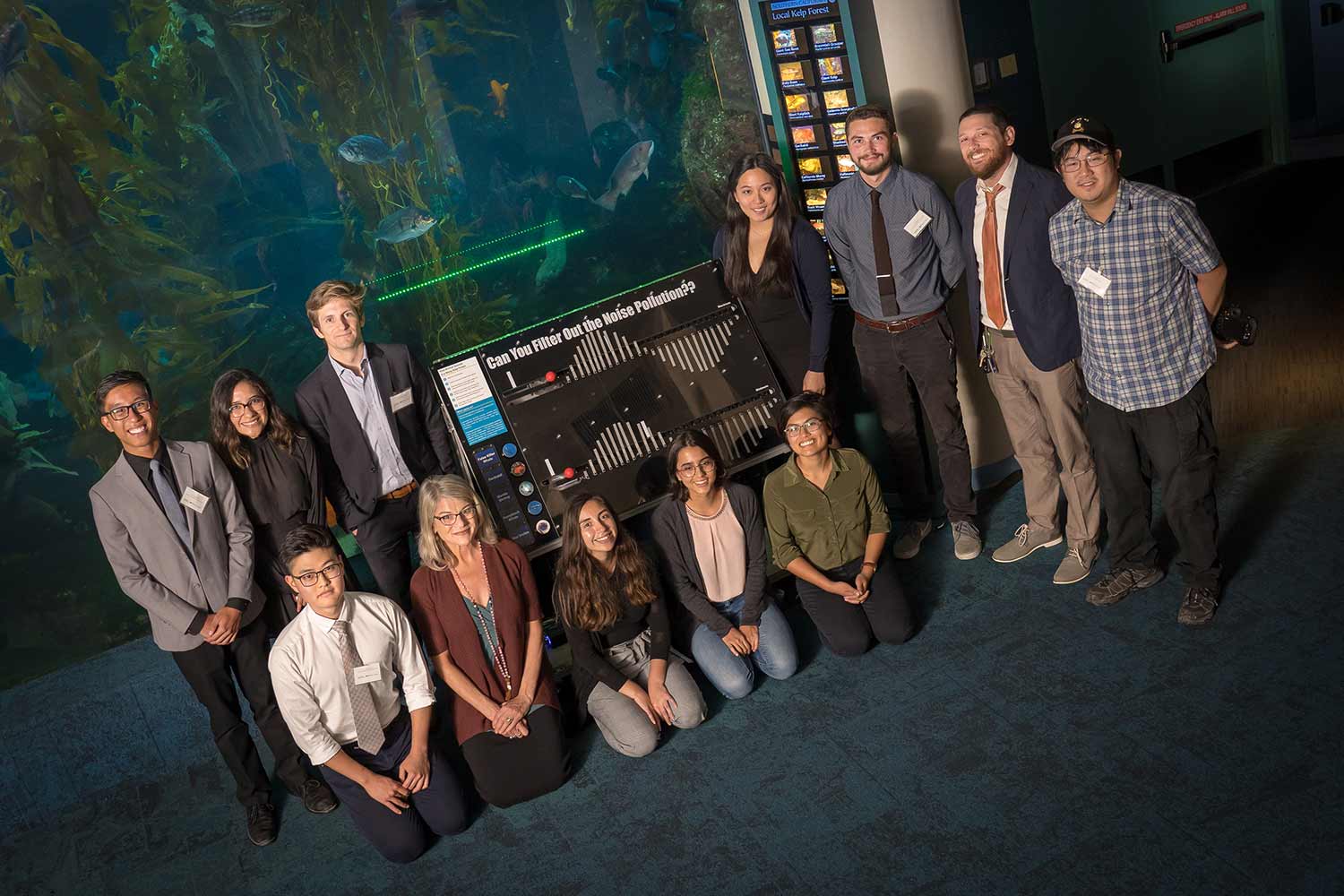
Undergraduate students and their Summer EnVision Experience mentors proudly unveil the exhibit they designed and built for Birch Aquarium in the Aquarium itself. Photo by David Baillot
UC San Diego Undergrads Design New Birch Aquarium Exhibit
Ten UC San Diego undergraduate students. Ten weeks. One floor-ready, interactive museum exhibit.
If it sounds like a herculean task, that’s because it is: professional exhibit designers can take years to create a museum-ready exhibit. But leaning on their interdisciplinary skills, teamwork, and guidance from mentors, the 10 students built a sound-matching game in 10 weeks that translates complicated scientific research into an exhibit that will soon be on display at Birch Aquarium at Scripps.
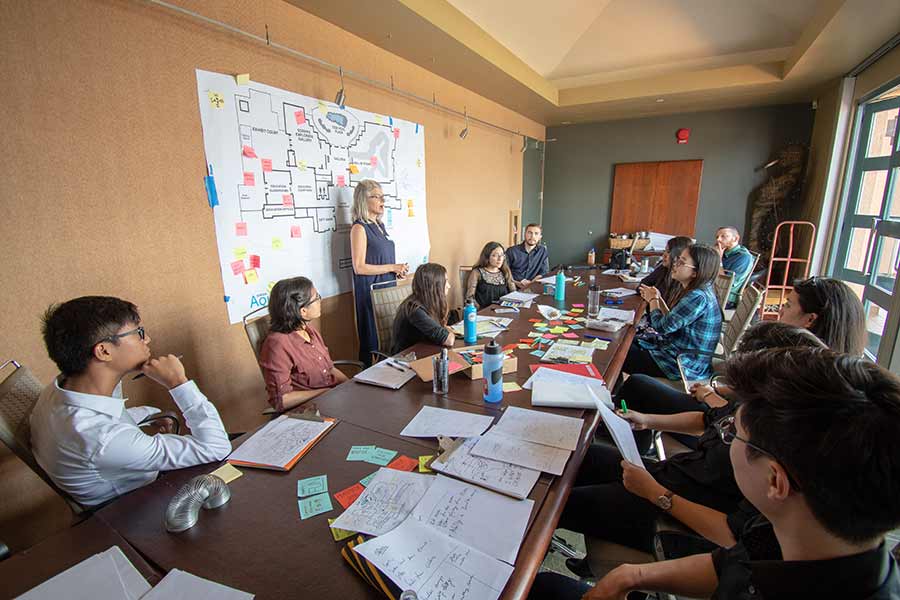
Nan Renner, senior director of learning design and innovation at Birch Aquarium, helps students get their creative juices flowing at a design jam at Birch Aquarium. Photo by Mark Liu
It’s part of the Summer EnVision Experience (SEE), which brings together UC San Diego undergraduate students from multidisciplinary backgrounds to collaborate on a hands-on, real-world project from start to finish. EnVision mentors guide the students through product development for a client: Specifically, the SEE team is tasked with translating research from Scripps Institution of Oceanography into an exhibit that is fun, informative, and functional.
This year, the students focused on the concept of waves—sound waves, ocean waves, compression waves, any kind of physical waves. They started by making as many different wave-based low fidelity prototypes as they could using rapid design methods and hot glue, Styrofoam and balsa wood. Twelve of these prototypes were tested with Aquarium visitors for some early user feedback.
With input from the Birch Aquarium’s Exhibits team, the students whittled those down to seven concepts, then to three, which they built as higher fidelity prototypes.
The winner?
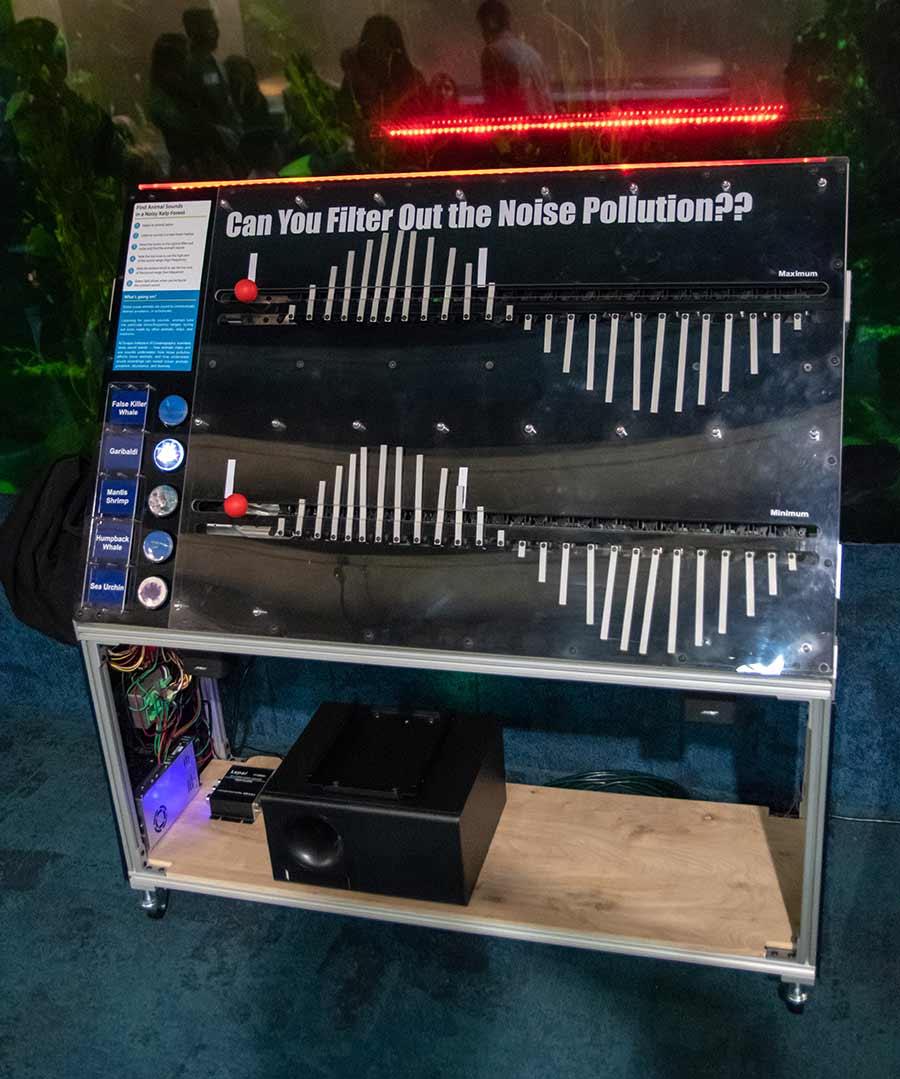
The student interns designed a multi-sensory sound matching exhibit inspired by research from Scripps Institution of Oceanography. Photo by David Baillot
A sound-matching game inspired by research from UC San Diego Professor John Hildebrand’s Whale Acoustic Lab. The multisensory exhibit lets the user hear sounds made by five different marine animals, and then physically manipulate the corresponding wave shape to focus on the narrow frequency band of one specific animal’s sounds.
“Most of us think of the ocean as a quiet, peaceful place, but it actually really isn’t,” said Hazel Leung, a fourth year cognitive science student and Summer EnVision Experience participant. “There are a lot of animal sounds, ship sounds, machine sounds—they’re all going on at the same time. This exhibit aims to help the visitor understand that noise pollution is a really big factor in how some marine animals communicate and use echolocation, and how Scripps Institution of Oceanography is currently doing research around that.”
To get the job done, students had to tackle not only a tough engineering and user experience challenge, but navigate the added factors of time, budget, and teamwork.
“The most surprising part of this project was that the design requirements weren’t obvious, we had to figure them out together with our client,” said Chris Bayag, a third year mechanical engineering student at the Jacobs School of Engineering. “In class you might be told to build a robot with these specific constraints. But for this, we were just told to make an exhibit, and the rest was up to the design process.”
Students drew inspiration from design jams at Birch Aquarium, where they saw how visitors interacted with current exhibits and conducted early user testing, as well as a visit to the San Francisco Exploratorium, renowned for the hands-on nature of its exhibits.
“We did a kind of experiment this summer by not pre-defining the project, but by saying only that we wanted to do an interactive science exhibit about the physics of waves, which is a huge space,” said Nan Renner, senior director of learning design and innovation at Birch Aquarium. “The students had a really ambitious goal to achieve, and I think the end result reflects all of the extra effort they invested in this, as well as the benefits of multidisciplinary collaboration to the design process.”
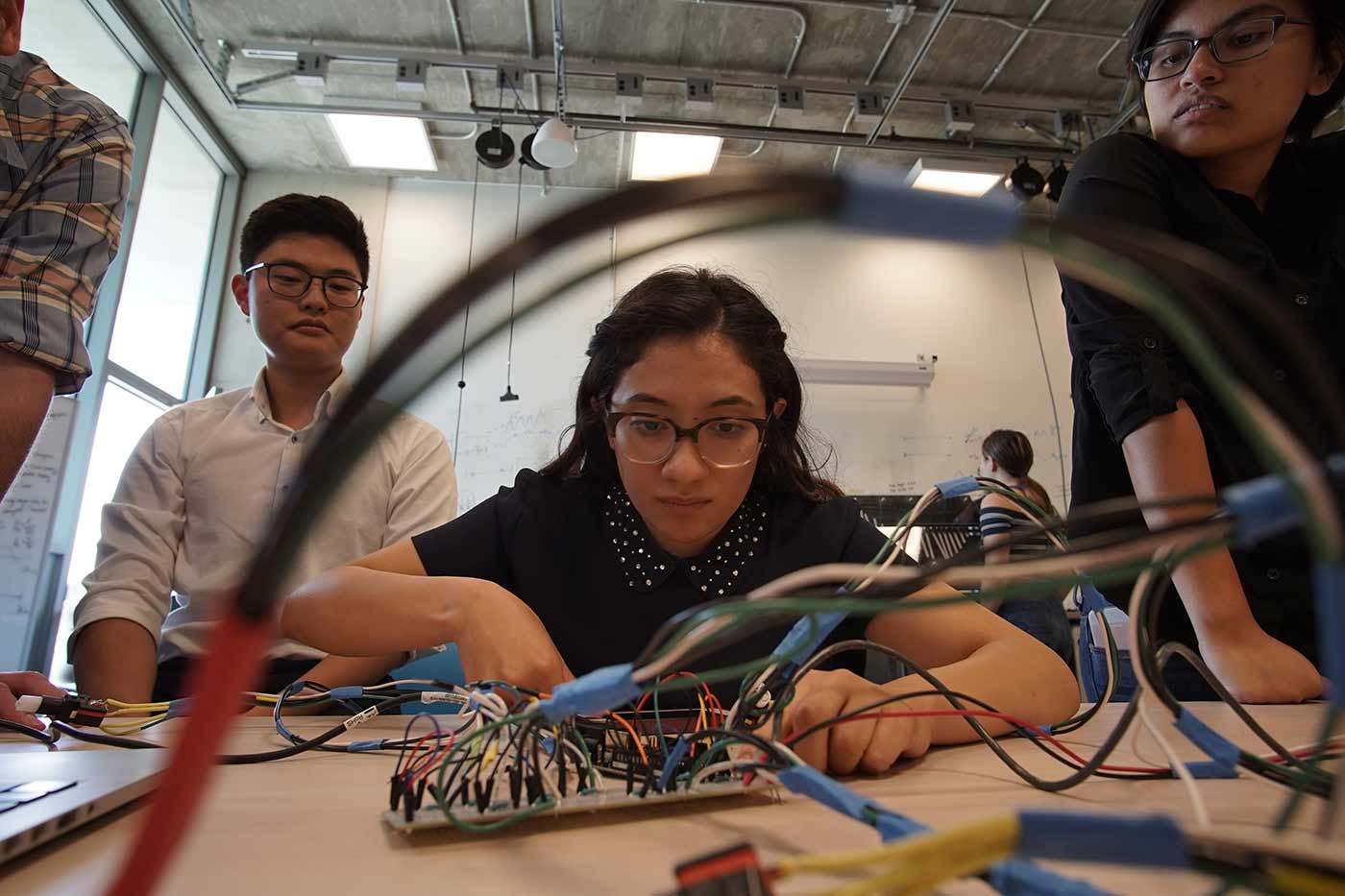
Summer EnVision Experience intern Marianna Perez works on the electrical components of their exhibit in the EnVision Arts and Engineering Maker Studio. Photo by David Baillot
In addition to the collaboration between students from different academic disciplines, the SEE team got feedback and guidance from Birch Aquarium, Scripps Oceanography, the Rady School of Management, and the Gordon Engineering Leadership Center and Career Services.
Jesse DeWald, director of the Summer EnVision Experience and its namesake EnVision Arts and Engineering Maker Studio, said the internship is designed to provide students with the kind of hands-on, practical experience that they’ll need after they graduate. The EnVision Arts and Engineering Maker Studio is a hybrid lab and classroom that provides undergraduate engineering and visual art students with a space where theoretical coursework and hands-on experience intersect.
“This is what it’s like in the real world—you’re given a project, and expected to interface with all the different people necessary to get the job done,” DeWald said. “Over the course of 10 weeks, the students put to practice the technical skills they’ve learned in the classroom, while learning first-hand the importance of project management, team building and documentation.”
That’s no accident. Hands-on learning to solve relevant skills is a key focus of Albert P. Pisano, dean of the Jacobs School of Engineering, and his Experience Engineering Initiative.
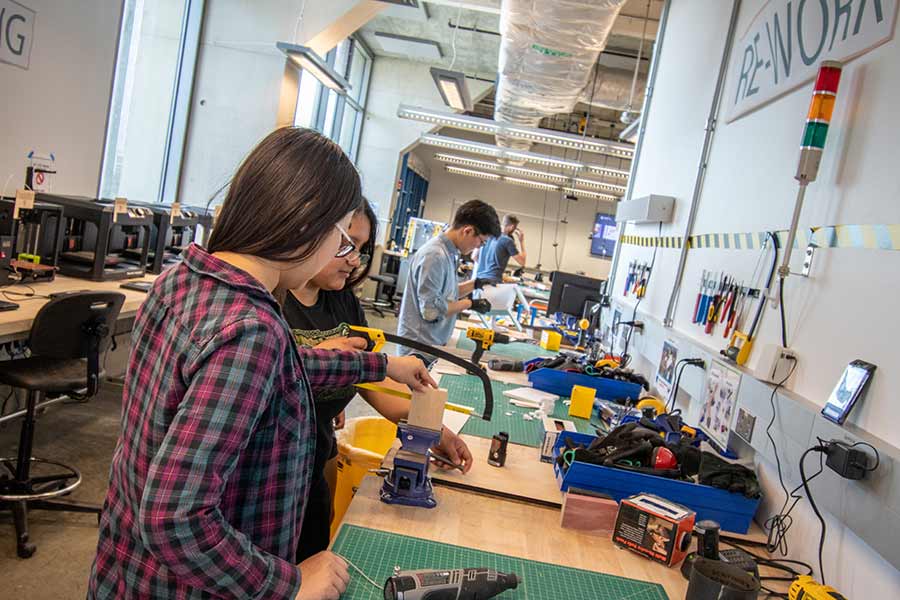
Summer EnVision students use tools in the EnVision Arts and Engineering Maker Studio to build prototype exhibits of varying levels of fidelity. Photo by Mark Liu
“It is a very high priority to engage engineering students in real hands-on projects,” he said. “What that means is you really have to invent or make something, you really have to pitch it to somebody, and you really have to follow through and do it. And oh, by the way, it’s going to be out where the public can evaluate it as well.”
This is the second year that the Summer EnVision Experience partnered with Birch Aquarium at Scripps. In 2017, students built a prototype exhibit styled after an air hockey table with light sensors to help visitors understand the albedo effect, as well as an interactive radio-frequency identification (RFID) system to create a more personalized experiences for aquarium visitors.
The team from Birch Aquarium, as well as Jacobs School of Engineering, students, staff and beta testers all agree the program is a success, and expect a third installment in 2019. There’s only one problem:
“For every student you see here, there are 11 that we could not admit—120 people applied for these 10 slots,” Pisano said. “So we’re looking for continued and expanded collaboration here. The value to the students is incredible, and we’re grateful to our partners who can help this program grow. We’re also grateful to these students who will take the knowledge learned over this summer and pay it forward as mentors to fellow students.”
Share This:
You May Also Like
Engineers Take a Closer Look at How a Plant Virus Primes the Immune System to Fight Cancer
Technology & EngineeringStay in the Know
Keep up with all the latest from UC San Diego. Subscribe to the newsletter today.



